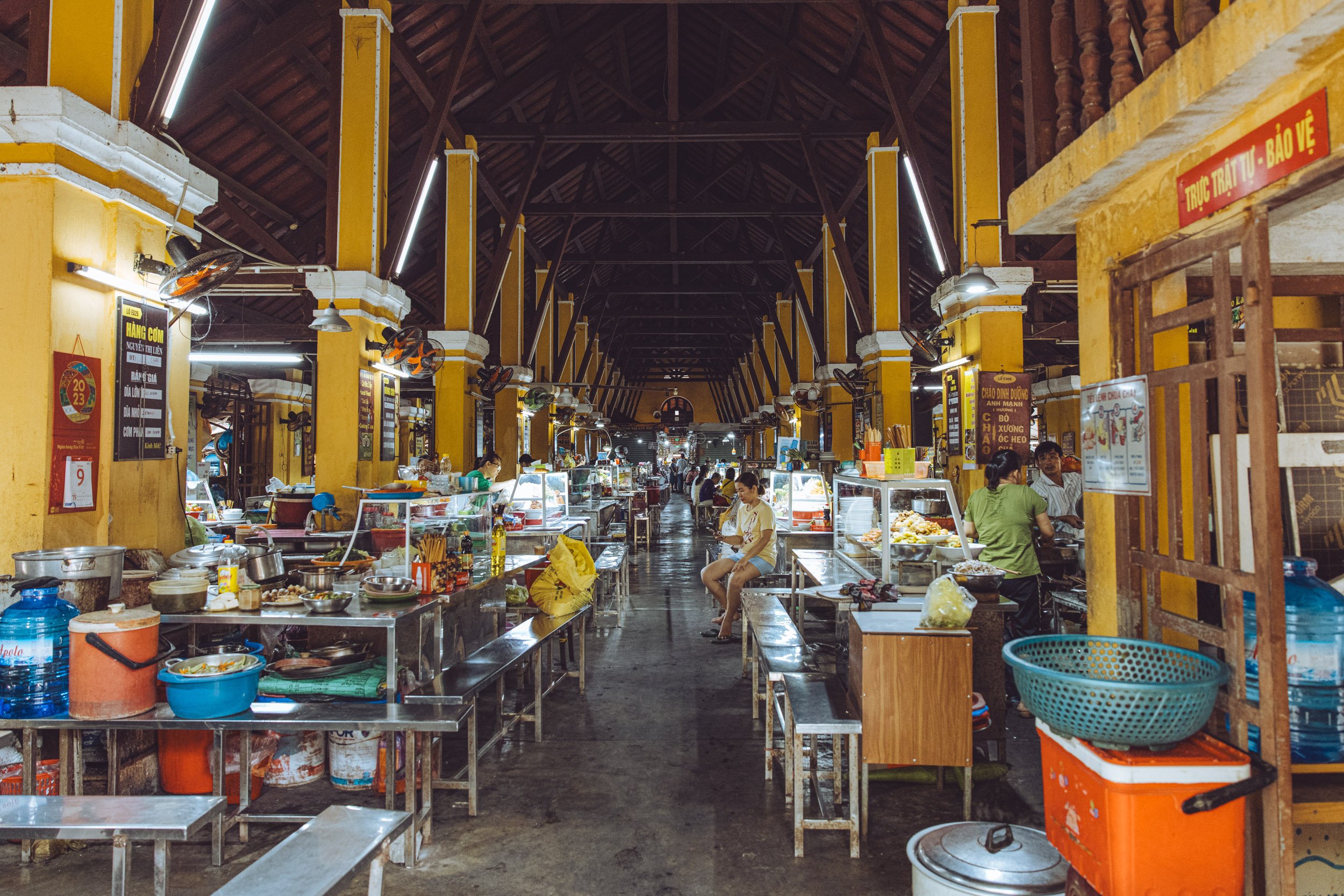Charm Offensive: Hoi An
Fruit seller in front of the famous yellow wall of an old merchant house
The old city of Hoi An has all the makings of a tacky tourist trap. Countless shops peddle cheap knick-knacks and the obligatory I ♥️ Hoi An t-shirts. Hordes of Instagrammers roam the streets taking earnest looking pictures down charming alley ways; ancient women with fruit baskets on bamboo yokes proposition you for photos whilst you dodge the rickshaws and bicycles that glide through the streets.
In the early evening the historic waterway is an anarchy of boats and any notion of romance is smothered under ill-fitting life jackets. Every other conversation is with a street seller touting an intricate paper pop-up book or refusing peanut sellers with their “if you don’t try, you’ll never know” sales pitch.
Yet Hoi An is utterly charming. The iconic yellow houses are pretty and well kept, tinged with Hollywood-perfect decay. Amongst the souvenir shops are gems of good design and great tailoring. Bougainvillea cascades from baked tile roofs and dainty lanterns criss-cross the streets. Walk through the town at night and you drift through fragrant pools of white and red jasmine that infuse the evening air.
There is a dignity in the architecture and layout of the town that recalls its position as one of South East Asia’s most important trading ports, giving Hoi An a gravity of beauty and charm that somehow manages to keep the tackiness at bay and the people are beyond friendly and kind.
It’s not all tourist shops and at the east end of town is the Cho Hoi An, bustling market that spills across several streets. Markets are always one of best places to get a real sense of somewhere. Stalls display noodle mountains and fresh produce while local chefs inspect the morning’s catch. Foodies flock to the stall where Anthony Bourdain anointed the world’s best bhán mi and you can pick up a bowl of cao lao and an iced coffee for $2.50.
We walked up to the town most mornings to do a sort of self-directed coffee safari. We tried at least one of everything in multiple locations: egg coffee, salt coffee, coconut coffee and the staple Vietnamese coffee. All delicious and all very sweet and sugary. The best place we found was the Roastery who masterfully allowed the coffee flavours to come through in their drinks instead of the overpowering liquid desserts we found in many other places.
For food, Morning Glory and Hai Cafe were firm favourites. Nu Eatery was a compact little place down a side alley that riffed on traditional ingredients with a modern twist and the pork tacos were delicious.
Overall, Hoi An has everything from coffee, food and photography, and it was joyous to see the streets and shops busy with travellers after the harsh effects of the last few years. I didn’t buy one of the t-shirts, but I ♥️ Hoi An.
Any UNESCO site that has a Crocs shop in it should have its status immediately put under review
Hoi An Photography Field Notes
Hoi An is on an East / West axis so you get a good orientation for morning and evening light
I preferred the mornings as the town was still vibrant but there were far fewer tourists. The market is well worth visiting early to experience and capture the hustle and bustle as well as all the foods on display.
I had a tripod with me and was hoping to get onto some of the roof tops to see about sunset and blue-hour shots. The two easiest places I found I could get to were the roof of the Faifo Cafe and 92 Station. I had to buy a drink at 92 Station before going up and both rooftops had lots of people on them, but the turnover is high so you could probably park yourself there if you needed to. I think 92 Station was slightly better from a composition perspective. There are other restaurants and bars with rooftop access too, but these are the only two I went up.
I only attempted sunset once when I was there, but I noticed that the sun disappears behind a layer of haze before it ever really gets to the horizon, so I wasn’t blessed with epic skies. Maybe it’s better at different times of year.
Many people want $1 to have their photo taken. Some will encourage you to take a picture and then demand money after and others will be up front. Just be aware of this. As a general rule I prefer not to pay for photos, but might opt to buy some fruit or a drink from someone instead. I also found that just asking also works. Some people are happy to have their photo taken.
There’s the famous Hoi An Yellow Wall down by the water that offers a fantastic backdrop and some interesting details. I saw some good pictures of it in my research and if you find the gallery of the photographer Rehan there, you can see how he’s used it. Surprisingly though, very few people were there taking photos, so it’s sort of hidden in plain sight.
I found Hoi An generally easy to shoot as it’s compact and easy to walk around, and there’s lots of really great details to capture everywhere. It’s good to pay attention to the side alleys as you can often find interesting little compositions down them.
Delicious treats on display at the Cho Hoi An market
Choi An Market










































